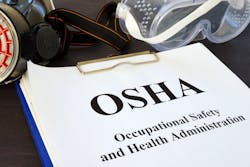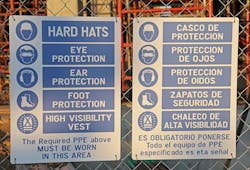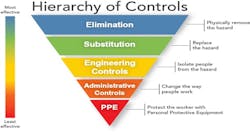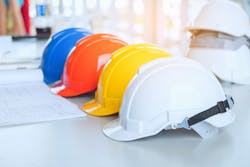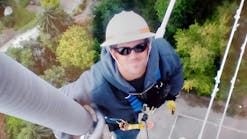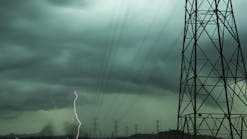Traveling Through Time: A Worldwide Look at Industrial Safety
Defective equipment, use of improper material, job contamination, substandard or limited training, inexperience on the job, weather conditions, unmanaged stress, incomplete/improper procedures, etc., can all contribute to the detrimental outcome of work to the unprotected worker.
For example, long ago in the United States and other countries, workers in mining and agriculture industries often didn't have any occupational health and safety standards. Then, during the 16th century, it became evident that a serious approach had to be developed to address the great numbers of occupational diseases, deaths and injuries that were occurring, especially in mining and agricultural operations.
Progress, if any, was slow. Then, during the 17th and 18th centuries, and the dawn of the “Modern Era,” in-depth professional studies, and observations were undertaken by concerned physicians and others, especially in Europe, to correlate and understand work activities vs. diseases and hygienist practices. Serious occupational health and safety investigations started. However, it was during the end of the 18th century and beginning of the 19th century, in Europe, with the advent of the “Industrial Revolution” that formal studies and treatises appeared in the society. “The Age of Machines” and the interaction with the human operators resulted, unfortunately, in a steady increase in incidents of occupational injuries, diseases or deaths. By the mid-19th century, the “Industrial Revolution” reached the United States, and with it, increased work-related calamities.
Taking Action
In the United States, the increasing number of incidents with injuries and deaths and accidents on the job demanded the attention from government and industries. Under pressure from workers, the Federal Congress created a federal agency to oversee the health and safety of workers in the workplace by assigning responsibilities to the employers and to the workers for following applicable rules and regulations. Hence, the Occupational Safety and Health Administration (OSHA) was established by Congress in April 1971 under the Occupational Safety and Health Act signed into law by President Nixon in December 1970. Having OSHA in place meant that the ongoing rate of worker injuries and deaths would decrease over time.
According to the U.S. Bureau of Labor Statistics (US BLS), prior to OSHA’s creation, the annual rate of injuries and illnesses in the United States was about 11 incidents per 100 workers (about 80 million workers in 1970). By 2018, this rate has dropped considerably to about 3 incidents per 100 workers. (With an active workforce of about 160 million in 2018.) Worker’s deaths rates, along the same period, came down from an average of 14,000 deaths per year on/prior to 1970 to 5600 on/around 2018, 2019 and 2020 (per year). Widespread educational aid to both workers and employers were necessary to assist them in complying with the consensus rules. A great effort into enforcement to assure compliance was also required as well.
A Worldwide View of Safety
To better measure the impact in the workforce populations of not only of the United States, but of also other countries, a brief review of health and safety actions and results in three Latin American countries follows.
- The Dominican Republic has a population of approximately 10.8 million people. The poverty rate (for a person earning $1.25 per day or less) is about 30%. Middle class is about 40%. The labor force is approximately 4.4 million. Of the 4.4 million, about 2 million works in the formal sector, with the remaining 2.2 million in the informal sector of the economy. The Dominican Institute of Occupational Risks and Prevention documents 24,131 disabling injuries in 2020. in 2015 there were 29,959, and in 2010, 13,150 injuries, respectively. About 77% of all disabling injuries occurred to workers with five years or less of experience. Unfortunately, about 64% of all injuries occurred to young workers (20 to 38 years old). Most injuries happened due to overexertion, falls, struck-bys, roadway accidents and slips and trips. There were 83 occupational deaths up to June of 2021.
- In Costa Rica, about 20% of the population is in poverty, with about a 70% classified as middle or upper class. The country has developed health and safety initiatives and commitments to reduce the rate of incidents and deaths in the workplace. Both the Labor Code and Article 66 of the Political Constitution of Costa Rica require that employers provide a decent, safe and healthy place of employment for all workers. A brief review of the occupational data issued by the Instituto Nacional de Seguro de Costa Rica (INS) reveals that the incident rate (injuries and illnesses) decreased from 10.3% (in 2015) to 8.3% (in 2020). About 9 workers per 100 were injured in 2014. Young males, with less than five years of experience on the job, had the most injuries (about 83%). Stress at work counted for 22% of injury causes. Long hours of work (48 hours per week minimum), violence and discrimination at work were also noted. Approximately 6300 occupational deaths per day occurred in the country. This can be divided into approximately 960 days per day due to accidents, and 5340 per day due to illnesses.
- For Nicaragua, a close examination of the available safety and health data issued by the Instituto Nicaraguense de Seguro Social (INSS), shows that employers participating in INSS reported that approximately 34,000 injuries and illnesses (incidents) occurred in 2019. These reported incidents come from data applicable to a percentage of the total workforce in formal employments, which contribute to the INSS. About 68% are classified as occupational accidents with 11,000 due to falls and 7400 incidents due to musculoskeleton disorders (MSD) among office workers, probably due to ergonomics issues.
In these countries, the need for reliable, consistent and enforceable field use of approved and practical occupational safety and health practices and standards is of paramount importance.
Understanding Hazards
One renowned and well-established technique is the application of the “Hierarchy of Hazard Controls” pyramid, created by the National Institute of Occupational Safety and Health (NIOSH) of the United States. This approach and understanding of all possible and potential hazards exposures, to better protect the well-being of workers, can be illustrated by degrees of effectiveness on the graph below:
In order of effectiveness to the workers (from most effective to least effective):
1) Elimination of the hazards ---Remove the hazards (e.g., just remove a pile of debris on the pathway)
2) Substitution of the hazards ---Change the worst offender for a much safer one (e.g., one volatile or acidic substance for a more stable and less or no acid type)
3) Engineering Controls ---Isolate the worker from the danger or hazards (e.g., place a barricade around a big hole or energized equipment)
4) Administrative Controls ---Change the way people work, use warning signs (e.g., conduct job briefings before work starts; place road signs to control traffic around workplaces)
5) Personal Protective Equipment, PPE ---Provide and use PPE to protect workers from hazards (e.g., hard hats for head protection; rubber gloves for electric energy protection; FR clothing for electrical flash and arc protection)
There is a work technique or practice of the Administrative Control category that has proven to be effective in raising the hazard awareness to the workers so as to enhance the possibility of incidents reduction on the jobsite—Daily Job Briefing.
A Daily Job Briefing is required before each job starts and anytime a change occurs on the job. If a new worker comes to the crew to work after the job has started, then another Job Briefing must be done. For it to be effective, all workers, not only the supervisor, on the crew must actively participate: Ask questions; have a questioning attitude; be honest voicing hazard concerns; contribute to the discussion, etc. The following five main items should be up for discussion at each briefing:
a) Hazards --- All present and expected dangers and hazards on that job must be discussed, along with proper solutions.
b) Procedures ---Work procedures and instructions that apply to the job at hand must be discussed and recorded on the Briefing Form.
c) Precautions ---Discuss and list all precautions applicable to the work.
d) Energy Protection ---Discuss how and who will make equipment non-operational to prevent accidental energization of equipment while the work is going on. Warning tags to be posted.
e) PPE ---Get and use Personal Protective Equipment to protect the workers from the hazards .
Following is a brief list of some of the most common PPE available in general industries:
- Flame-Resistant (FR) Clothing ---Protection from arc flashes and/or other electrical/heat hazards
- Eye and Face Protection ---Protection from flying particles, molten metals, liquid chemicals, Chemical gases or vapors, and/or dangerous light radiation
- Foot Protection ---Protection from falling or rolling objects, or from crushing or penetrating materials
- Hand Protection ---Protection from severe cuts or lacerations, severe abrasions, skin absorption of harmful materials, punctures or chemical burns, thermal burns, or harmful temperature extremes
- Head Protection ---Hazard protection from falling objects that could strike the head
- Hearing Protection ---Protection against excessive noise in the workplace (usually 85 decibels or more on an 8-hour time weighted average
- Personal Fall Protection ---Requires to protect workers whenever they are working four feet or more above a lower level, or when working over dangerous equipment and machinery
- Respiratory Protection ---Necessary whenever workers enter an oxygen-deficient environment, dusts, fogs, smokes/fumes, gases, vapors and sprays. These substances can cause cancer, lung diseases or death
- Walking/Working Surfaces ---Protection must be provided to prevent workers from falls, slips, and trips. Proper housekeeping is required to prevent accidents
Occupational health and safety rules and regulations in the majority of countries do charge the employers with the responsibility to provide decent, safe and healthy employment and place of employment to all workers under their control. Of course, workers must follow and obey all applicable safety and health rules as well. So, is work really a cause of injuries or death? It shouldn’t be. What do you think?

